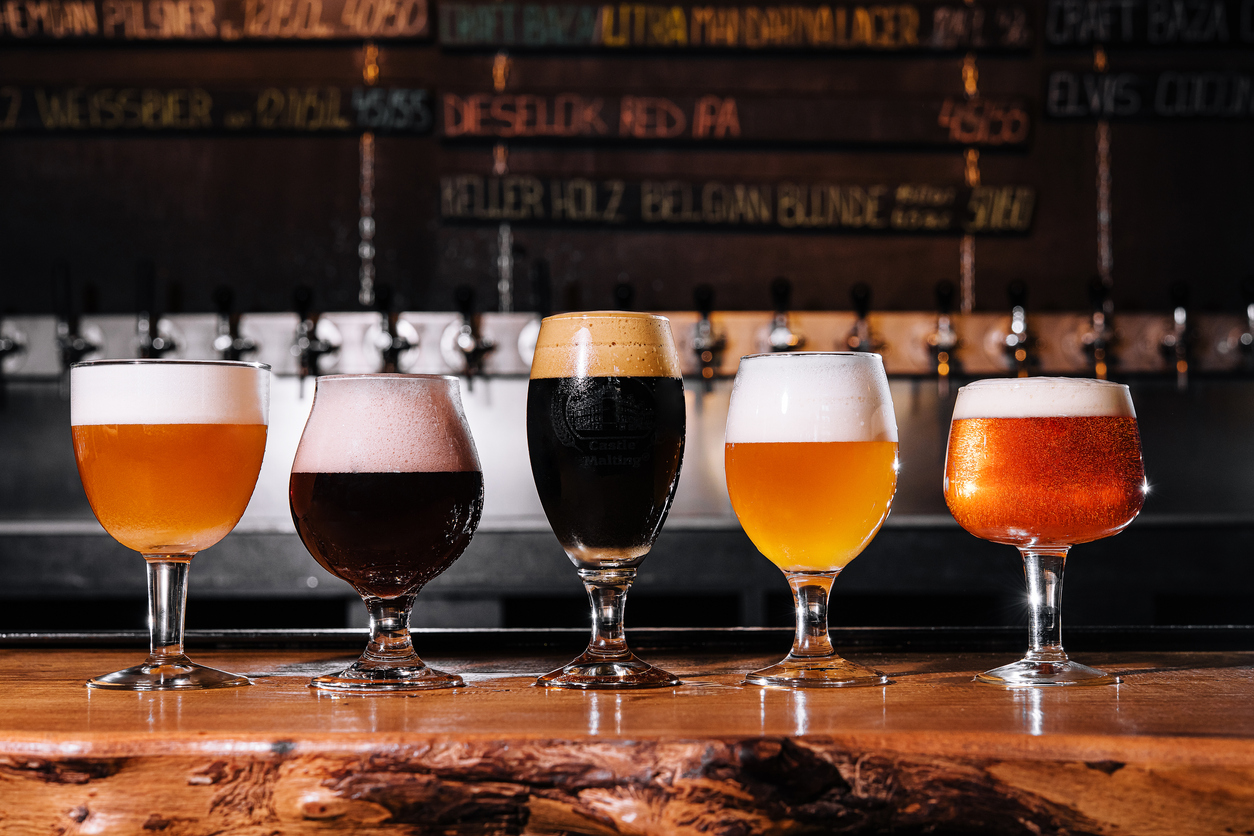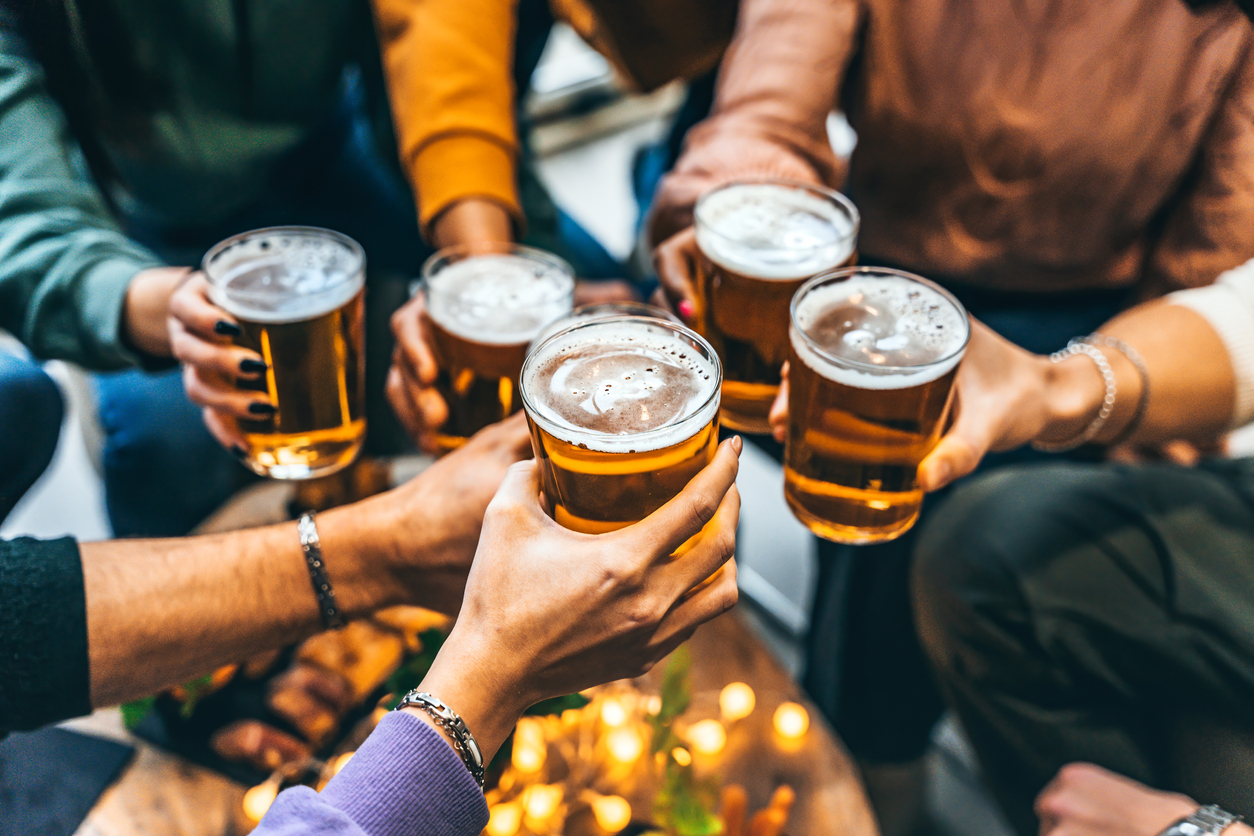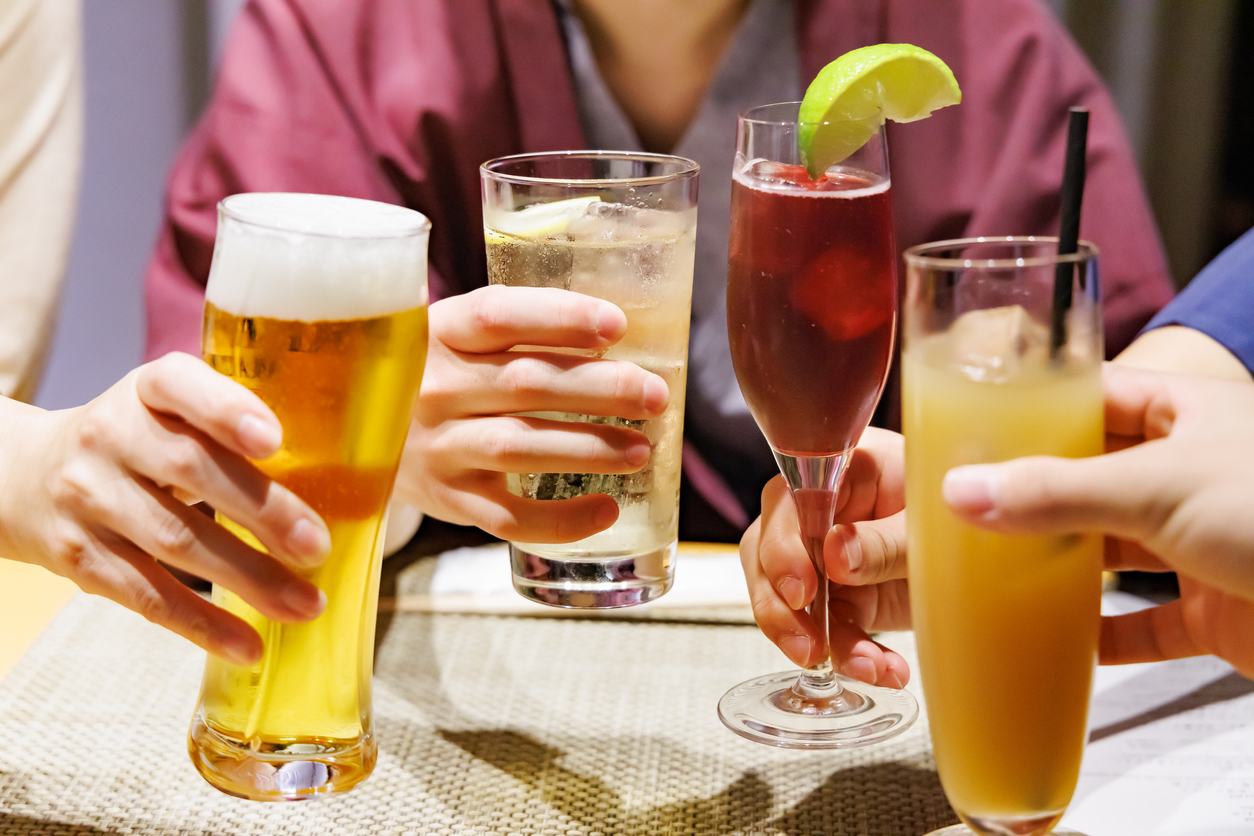Beer and Hard Seltzer: The Ultimate Diabetes-Friendly Guide
By Erin Davis
 Beer is an alcoholic beverage that’s been enjoyed for centuries, while hard seltzer is a popular low-carb drink that’s relatively new on the scene. Here’s everything you need to know about beer and hard seltzer if you have diabetes.
Beer is an alcoholic beverage that’s been enjoyed for centuries, while hard seltzer is a popular low-carb drink that’s relatively new on the scene. Here’s everything you need to know about beer and hard seltzer if you have diabetes.
If you like beer, you’re not alone. In 2021, more than 7 billion gallons of beer was consumed. And if you’ve noticed the upsurge of White Claw boxes lining liquor stores, it’s clear the hard seltzer market is booming, too.
While some relish the wide variety of beers out there, others are choosing spiked seltzers and other lower-carb alternatives.
“Currently, I’m noticing individuals gravitating towards low alcohol-by-volume beers and seltzers,” said Christa Brown, a registered dietitian specializing in type 2 diabetes management. “Some of my patients want to enjoy a light spritz without all the guilt and side effects of a regular adult beverage.”
All about beer: nutritional facts
There seems to be a million types of beer these days, but the process of making this popular beverage is essentially the same. Beer is an alcoholic beverage made by the fermentation of grain and is typically flavored with hops.
“Cereal grains such as malted barley are converted to sugars,” said registered dietitian Lori FitzPatrick, who described the brewing process. “Additional carbohydrates may be added as starch or sugar adjuncts, such as adding oats to an oatmeal stout, rice to a rice lager, or lactose (milk sugar) to a milk stout or milkshake IPA.”
Naturally, these carbs matter and can easily add up.
“Many of those sugars are fermented by yeast to make alcohol, but any residual sugars left after fermentation are included in the total carbohydrate count,” FitzPatrick explained.
When it comes to choosing beer based on nutrition, it can be tricky. Traditional American-style lagers, like Budweiser and Coors, have standard ingredients and calorie counts. But craft beers likely will not.
“Craft beers contain a wide variety of calories, carbohydrates, and alcohol,” FitzPatrick said. That means your glass of beer may have a completely different nutrient profile than your barmate’s beer of choice.
“To make things even more confusing, craft beers are offered in many different volumes, and nutrient labeling is not required for malt beverages,” FitzPatrick said.

However, the beer industry isn’t completely off the hook.
“If you claim your product is ‘light’, then you need to support that by including nutrition information,” said Dakota Soule who works at Upper Hand Brewery in Michigan. Typically, the lower the ABV (alcohol by volume), the lower the calorie count will be.
“Most light beers have a lower ABV, around 4.0-4.6%,” Soule said.
Whether you prefer the hoppy and bitter taste of an IPA or the rich and nutty flavor of a porter, you’ll have to be mindful of how it will impact your blood sugars and health goals. Below, you’ll find the calorie and carb count averages for different types of beer.
Ales
Ale is a type of beer fermented for a short amount of time at a warm temperature. A popular type of beer among craft brewers, ales can be made in as short as seven days. Here are some of the most common ales:
Indian pale ale
Nutrition per 12 oz. serving
Average calories: 170-240 kcals; Average total carbohydrates: 11-20 grams; Average ABV: 5.0-8.0%
Indian pale ale (IPA) is brewed with additional hops, which gives this style of beer its distinct bitter taste. Ranking high in popularity, IPA has more calories and carbohydrates than other beers. Because its alcohol content is a bit higher, there is more residual sugar and carbs.
Porter
Nutrition per 12 oz. serving
Average calories: 170-240 kcals; Average total carbohydrates: 15-20 grams; Average ABV: 4.0-6.0%
A rich, dark beer, porter is brewed with browned malted barley at a high temperature. The result is a full-bodied, bitter-tasting beer loved for its creamy mouthfeel. While this dark beer may be higher in calories than a light brew, it is rich in flavonoids, which are loaded with antioxidants.
Stout
Nutrition per 12 oz. serving
Average calories: 150-220 kcals; Average total carbohydrates: 10-20 grams; Average ABV: 4.0-6.0%
Stout is a dark beer that has a distinct toasted flavor due to the roasted grains utilized in the brewing process. It’s similar to a porter but can be thicker and more bitter. Again, the calorie count boils down to the ABV. The greater the ABV, the higher the calories and carbs.
Lagers
Lager beer is fermented for longer periods at a low temperature. The biggest beer producers in the U.S. make this type of beer. When it comes to choosing a beer for people with diabetes, FitzPatrick suggested that lagers may be a good choice.
“Lagers typically contain less carbohydrates and are also less likely to have long lists of added ingredients associated with residual sugars,” she said.
American style lager
Nutrition per 12 oz. serving
Average calories: 95-110 kcals; Average total carbohydrates: 3-7 grams; Average ABV: 4.1-4.2%
This type of beer might be the most recognizable, having dominated the beer cooler long before the boom in craft brewing. Brands like Miller, Coors, and Budweiser make light lagers that are some of the top-selling in the nation. Out of all beers, light lagers are the lowest in carbohydrates and calories.
Pilsner
Nutrition per 12 oz. serving
Average calories: 95-160 kcals; Average total carbohydrates: 9-17 grams; Average ABV: 4.5-5.0%
Originating in the Czech Republic, pilsner is a pale, golden lager. Loved for its refreshing flavor, pilsners are a popular summer beer. Because of its lower ABV, pilsner is often lower in calories and carbs than darker beers.
Gluten-free beer
Nutrition per 12 oz. serving
Average calories: 65-200 kcals; Average total carbohydrates: 5-15 grams; Average ABV: 4.0-5.0%
Fortunately, a growing number of gluten-free beers are available, providing an option for those who have celiac disease or gluten intolerance. Gluten-free beer is brewed using grains like rice, millet, buckwheat, corn, and sorghum.
There are also “gluten-removed” beers, which are made from gluten grains, but processed with gluten-digesting enzymes. While this option may be fine for someone with a slight intolerance, it wouldn’t be recommended for someone with a severe gluten allergy or celiac disease.
What about hard seltzer?
It’s impossible to enter the beer aisle and not notice the growing number of hard seltzer offerings. Hard seltzer is made with carbonated water, alcohol, and flavorings – often fruit juice.
Lena Bakovic, a registered dietitian with Top Nutrition Coaching, explained why spiked seltzer may have additional appeal.
“They tend to be gluten-free because they do not contain barley or wheat like beer.”
Keep in mind that even though hard seltzers may be marketed as low-carb, these products still contain alcohol. They may taste light and refreshing, but like other alcohols, too much hard seltzer could be detrimental to your health.
Studies have found that heavy alcohol use can lead to a host of health problems including liver disease, pancreatitis, and more. In addition, alcohol can affect your sleep quality. Poor sleep not only affects blood sugar but also food choices and overall health.
The hard facts
So, what should you look for in a hard seltzer? First and foremost, registered dietitian Amy Beney recommends looking at the nutrition facts.
“Hard seltzers such as White Claw or Truly's are made with fermented cane sugar or corn, which is then combined with sparkling water and infused with fruit flavors,” Beney said. “They may be sweetened with stevia, which does not increase glucose or insulin levels.”
Low-carb hard seltzer
Nutrition per 12 oz. serving
Average calories: 100 kcals; Average total carbohydrates: 2 grams; Average ABV: 4.0-5.0%
Many spiked seltzers are made with no added sugar, making them a low-carb drink option. You’ll know which brands are low-carb by their labeling – it’s usually prominently placed on the packaging (though it’s still always a good practice to check nutritional labels, just to be safe).
While some seltzers offer just a refreshing hint of fruit flavor, others use stevia and sugar substitutes for added sweetness. Most seltzers are gluten-free.
Vodka seltzer
Nutrition per 12 oz. serving
Average calories: 95-110 kcals; Average total carbohydrates: 2 grams; Average ABV: 4.0-5.0%
As the name implies, vodka seltzer is made with carbonated water and vodka. Usually, there is fruit juice or flavoring added. In most cases, vodka seltzer is another gluten-free alternative.
Precautions for drinking alcohol with diabetes
It's recommended that everyone consume alcohol in moderation, but it’s particularly significant for people with diabetes.
Here’s why. Your liver, which prevents hypoglycemia (low blood sugar) by releasing glucose into the blood when you start to get low, prioritizes processing alcohol. Alcohol can also interact with certain medications, including ones that lower blood sugar.
As a result, you may experience delayed hypoglycemia after drinking alcohol, especially if you are on diabetes medications or insulin.
“Because alcohol can influence glucose for up to 12 hours and produce a potential hypoglycemic event, experts usually recommend testing blood sugars before going to sleep,” Bakovic said.
Tips for choosing beer or hard seltzer
If you have diabetes and want to savor a drink or two, here are a few pointers for choosing what to sip:
-
Don’t drink on an empty stomach: Beney suggested eating a snack before drinking. “I often recommend something small, such as Greek yogurt, fruit, vegetables, hard-boiled eggs, or a higher fiber carb or protein snack. It can prevent overeating and will make it less likely to choose higher-calorie or higher-fat food items on a menu.”
-
Keep an eye on your blood sugar: Because you are at greater risk for low blood sugar after drinking, make sure you are monitoring for hypoglycemia.
-
Stay hydrated: Beney recommended drinking plenty of water. “Ideally drink water throughout the day or before you leave. You may be thirsty and drink more alcohol than planned. Proper hydration status can be important for blood sugar control, whether or not alcohol is consumed.”
-
Look for the low-carb option: “Beers with ‘low carb’ or ‘low calorie’ claims must meet additional labeling requirements and are more likely to list specific calorie and carbohydrate amounts,” said FitzPatrick.
-
Limit your drinks: The American Diabetes Association Standards of Care recommends that women with diabetes consume no more than one drink per day, and men no more than two drinks. To keep your drinking moderate, alternate your alcoholic beverages with water or mocktails. FitzPatrick also advised mindful drinking if you like the higher-carb beers. “Ask for a smaller pour at a brewery or split a beer with a friend to help moderate your intake,” she said.
-
Choose beers with lower ABV: Typically, the lower the ABV, the lighter on carbs and calories the drink will be. For a calorie count, FitzPatrick suggested plugging the ABV and volume of your favorite beer into a standard drink calculator to see how it stacks up to one standard drink.
-
Try a non-alcoholic alternative: “Consider trying hop water or hop tea for a non-alcoholic way to be hoppy and healthy,” FitzPatrick said. “But be mindful of non-alcoholic beers, as these often contain just as many, if not more, carbs than standard beers to rival the taste without the alcohol.”
Learn more about drinks, diet, and diabetes here:








